
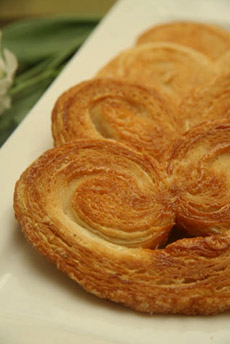 Photo of palmier puff pastry cookies courtesy FinancierPastries.com. Photo of palmier puff pastry cookies courtesy FinancierPastries.com.
June 2009
Last Updated March 2014
|
 |
Pastry Glossary: Pastry Type(s)
Galette & Other Types Of Pastry & Pies
Page 7: Definitions With Pa
This page contains different pastry type(s) such as paste, pastie and pâte à choux. This is Page 7 of a ten-page glossary. Click the black link below to visit other pages. See our many other food glossaries, each featuring a different favorite food.
PALMIER or ELEPHANT EAR COOKIE
A palmier is a cookie made of sheets of puff pastry that are rolled in sugar and folded to resemble palm leaves (palmiers) or elephant ears, depending on your perspective. These cookies are baked until the sugar becomes caramelized. See photo above.
PANDOWDY
A pandowdy is a spoon pie with a rolled top crust that is broken up to allow the juices to come through. See cobbler.
PARCHMENT PAPER
A heavy, grease-resistant paper used to line cake pans or baking sheets. Parchment paper creates a nonstick surface on bakeware and other surfaces. It makes it especially easy to remove delicate baked goods from the baking pan. There is no need to pre-grease or wash pans; the piece of paper, which has a one-time use, is thrown away.
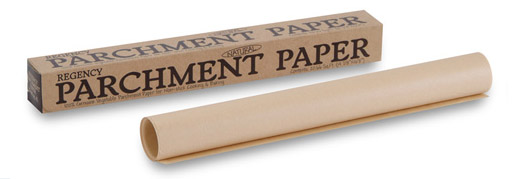
Parchment paper. Photo courtesy Chefs.com.
PARIS BREST
A pastry ring made of pate à choux, that is split and filled with crème pralinée (praline cream) and topped with almonds or confectioner’s sugar (see photo at right). The Paris-Brest-Paris, launched in 1891 as a 1200km bicycle race from Paris to Brest and back to Paris, is the oldest long-distance cycling road event.
|
|
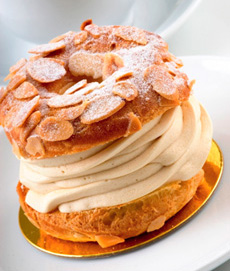
Paris Brest. Photo courtesy FinancierPastries.com. |
|
PASTE
A mixture of flour, water or milk, a fat (shortening) and sometimes a beaten egg, that creates a dough that is baked to make pie crust and other pastry. Pastry-making was practiced by the ancient Greeks and Romans, but the modern development of the types of Western dough we know today dates from the late 18th century. See pastry types, below.
PASTICIOTTI
Pasticiotti (from the Italian pasta ciotti) are shortbread tarts filled with with ricotta cream, vanilla or chocolate pastry cream or custard and sprinkled with confectioners’ sugar. In Rome, they are called bocconotti.
|
|
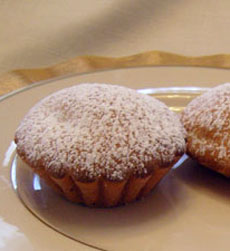
Pasticiotti. Photo courtesy
LucioBellosPastry.com.
|
PASTIE or PASTY
A pastie is a U.K. term that is similar to a turnover or an empanada. It is made by placing the filling on a flat pastry shape, usually a circle, and folding it to wrap the filling, crimping the edge to form a seal. The result is a raised semicircular package, which is baked. Pasties are made with many different types of fillings; the traditional Cornish pasty has diced beef, sliced potato and onion.
|
|
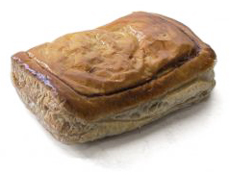
A rectangular-shaped cheese pastie. Photo by Mark Mordecai | SXC. |
PASTRY or PASTRY TYPES
Pastry refers to foods made of paste (see above), or having a crust made of paste. This large category includes pies and tarts, cheese straws, cream puffs and other sweet and savory foods. Pastry is classified according to the amount of shortening used and the method of blending it with the flour. For example, plain pastry is used to cover fruit or meat pies; flaky pastry, which requires more shortening than plain pastry, is used for strudels and baklava. Puff pastry is used for airy cream puffs and éclairs. Some of the other different types of pastry include Catherine’s pastry, galette pastry, hot water pastry, short crust pastry and stirred pastry. Cookie crumbs, meringue, nuts and even mashed potatoes (in shepherd’s pie) also serve as top crusts.
PASTRY BAG
Traditionally, a pastry bag has been a V-shaped cotton bag; metal nozzles of various sizes and shapes are attached to the ends and used to decorate or fill cakes, cookies and pastries. Today, many chefs use disposable plastic bags for easy clean-up.
PASTRY BLENDER
A utensil used to make dough, which cuts solid fats such as butter and shortening into dry ingredients such as flour and sugar. As a substitute, use two knives and cut in the ingredients with criss-cross motions.
|
|
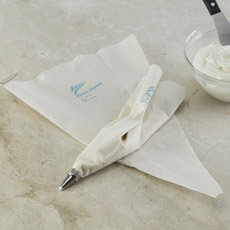
Pastry bag. Photo courtesy Chefs.com. |
PASTRY BOARD
A square or oblong board upon which pastry is rolled out. Marble is preferable because its cool surface keeps the dough cooler, but wood is more common. Professionals roll out on metal tables, which also keep the dough cool. Home bakers often install granite kitchen counters.
PASTRY BRUSH
A small basting brush used for glazing pastry with egg whites, melted butter, milk, etc. The most versatile ones these days have silicone bristles; the brushes can be washed in the dishwasher to fully sanitize them and remove any trace of flavors. They also do not lose bristles like the boar bristle and nylon bristle brushes. Boar bristles, however, are the most absorbent.
|
|
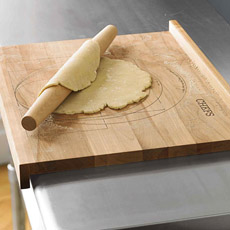
Pastry bag (above) and pastry brush (below) available from Chefs.com.
 |
PASTRY CHEF or PÂTISSIER
A culinary professional who focuses on pastries and/or desserts; some pastry chefs are experienced chocolatiers as well. Pastry chefs work in bakeries, restaurants, hotels, catering facilities and other establishments that require dedicated pastry professionals (as opposed to those that purchase pastry from outside suppliers). Pastry baking in a general kitchen is usually separated from the main kitchen. This section of the kitchen is in charge of designing and making pastries, desserts, and other baked goods, including breads.
PASTRY CLOTH
A reusable canvas cloth used to roll out dough in the absence of a marble or wooden board. The best ones have a nonstick backing. There is also a Silpat food prep mat that can be used for rolling dough, not to be confused with the pastry mat that goes into the oven.
|
|
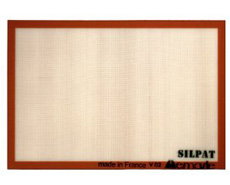
Silpat mat. More information. |
|
PASTRY CREAM
See crème pâtissière. Also known as confectioner’s custard.
PASTRY CRIMPER
A pastry crimper looks like a small pizza cutter; its purpose is to provide a professional crimped look on the crust of a pie or tart (see photo at right), instead of the homemade “pinched crust” look, and also to give a firm seal on a two-crust pie so the filling won’t leak. They also can be used for cookies, lasagna noodles, ravioli and other pasta shapes. A crimper is one type of pastry wheel.
PASTRY CUTTER
Like a small cookie cutter, pastry cutters in metal or plastic make various shapes to cut biscuits, scones and pastries, and to make dough decorations for pies and pastries (like the pumpkin cutout on the pumpkin pie above).
|
|
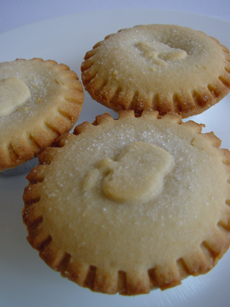
Pumpkin pies, showing crimped edges and a cut pastry decoration. Photo by Golders | MorgueFile. |
PASTRY CRUST
See crust.
PASTRY DOUGH
See pastry types, above.
PASTRY FLOUR or COOKIE FLOUR
Pastry flour is a soft wheat flour; soft flours have less gluten (a type of protein) than all-purpose or bread flour (8%-10%), which helps to produce a more delicate yet crunchier crust than other flours, rather than an overworked or tough crust. A good pastry is never leaden, but light, airy and buttery (or fatty in general, if another shortening is used). Whole-wheat pastry flour has a bit higher gluten level and produces a heartier pastry. While some people use all-purpose flour, very delicate pastries such as pâte à choux (puff pastry) or phyllo dough require lower-gluten flour to achieve the crispness and delicacy for which they are known. In general, while all-purpose flour works for a pie crust, pastry flour produces the crumbly, tender pastry that makes an excellent pie crust. If you can’t find pastry flour, you can mix four parts mix all-purpose to two parts cake flour to get similar results. Also use pastry flour for a more crumbly cookie (think shortbread or a cream cheese based cookie like rugelach), and for lighter scones and biscuits. In addition to the flour, pastry has a higher fat content than bread, which contributes to its flaky or crumbly texture.
|
PASTRY MAT or BAKING SHEET
LINER
A reusable silicone baking sheet that replaces parchment paper on baking sheets and jelly roll pans. The sheet can be used up to 3,000 times, and is heat-resistant up to 482°F.
PASTRY PRESS or COOKIE PRESS
Actually a tubular cookie press with different attachments that enable the dough to be forced through, creating a variety of designs.
|
|
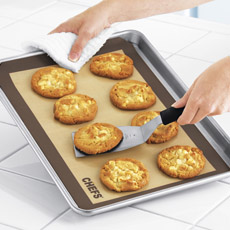
Reusable baking sheet liner available from Chefs.com. |
PASTRY RING
A baking accessory used to shape pastry (e.g. tarts) and hold it together during baking or assembly. Those designed for baking are typically made of metal or silicone; those designed for molding only can be made from plastic or any improvised material.
PASTRY SHELL
A pie shell, or bottom crust. These can be purchased frozen in any supermarket.
PASTRY WHEEL
A tool used to cut, shape and/or mold pastry. There are a variety of styles of pastry wheels, from rotary trimmers for a neat, uniform edge to cutters that produce uniform strips of pastry to pastry crimpers. Some wheels have removable inserts that do all of the above. Look for wheels that have large, soft ergonomic handles and are dishwasher safe.
|
PÂTE À CHOUX or CHOUX PASTE or PUFF PASTRY
Pâte à choux (also called choux paste or cream puff paste) is a very versatile dough; numerous sweet or savory pastries can be made with it. Some examples of savory pastries are gougères (cheese pastry) and pommes dauphine (crisp potato puffs). Just to name a few, sweet pastries include éclairs, cream puffs and paris-brest (a baked almond-topped pastry ring filled with a praline-flavored butter cream filling, and named in honor of a bicycle race between Paris and Brest.
|
|
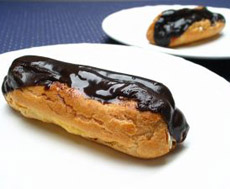
Éclairs. Photo by Mark Mordecai | SXC. |
Other sweet favorites include profiteroles (small round puffs that are served cold with a sweet filling such as ice cream and sometimes a topping), Saint Honoré (named after the patron saint of pastry), and religieuse (meaning “nun” in French, this is a large cream-filled profiterole topped by a smaller one, both glazed with fondant icing; it resembles a nun, hence the name), and croque em bouche. Pâte à choux is made by combining flour, butter and boiling water, then beating eggs into the mixture until it becomes very sticky and pastelike. During baking, the eggs create irregular domes in the pastry. Learn how to make pâte à choux. Or go straight to this cream puff recipe from chocolatier/patissier Michael Recchiuti.
PÂTE FEUILLETÉE
French for puff pastry.
PÂTE À FONCER
French for “lining dough,” this is a basic pie dough, but with a finer texture than American dough. It is made with butter at room temperature, instead of cold butter, for a finer and crisper crumb.
PÂTE BRISÉE
French for short crust pastry, used for pies and tarts.
PÂTE SABLÉE
A sweet tart pastry dough. Pâte sablée is rich and crumbly; sablé is the French word for sandy.
PÂTE SUCRÉE
Pâté sucrée is rich, sweetened short pastry used for tarts, plus pies and filled cookies.
PÂTISSERIE
The French word for pastry or pastry shop. In France, a pastry shop is different from a bakery (boulangerie), where bread is sold. n course or appetizer. Pies can have bottom crusts only, top and bottom crusts or, as with deep dish pies, only a top crust. Crusts can be made of a variety of recipes.
Continue To Next Page: Terms With Pe
Go To The Article Index Above

|















